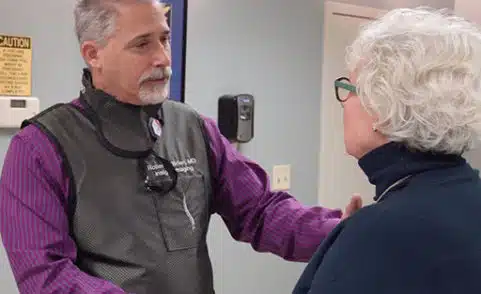

Getting around seems like a simple task. You don’t stop to think about that first step out of bed in the morning or walking from the garage into the house. Unless you have joint pain that’s getting in the way of your mobility.
Brenda Renrick can relate. She’d lived with pain in both knees for a long time – since childhood and she’s in her 70s! After a lifetime of struggling with her weight, which reached 265 pounds at the highest, it was Brenda’s knees that suffered.
And like a lot of people who suffer from joint pain, Brenda had tried pretty much everything to get relief. There was the arthroscopic surgery, the prolotherapy, acupuncture, chiropractic and much more.
Despite all the treatments, Brenda says she was always uncomfortable. “My husband sent an email to me about regenerative medicine. When I read it, I said, ‘I want to do this!’ It just seemed like the logical next step, given my previous efforts at diminishing the pain in my knees.”
From there, Brenda did her research. She searched online for information about regenerative medicine, then she scheduled a consultation with RAYUS. Brenda arrived for her consult armed with a notepad and a list of questions she needed answered.
Regenerative Medicine is a way to enhance or accelerate your own body’s healing process. In these types of therapies, your own cells are injected into the injured site, triggering your natural healing process. These cells can come from platelets in your blood or your own bone marrow. The platelet treatment option is known as PRP – Platelet Rich Plasma. BMAC is short for Bone Marrow Aspirate Concentrate and is a therapy that uses stem cells from your own body.
If your treatment plan calls for a PRP procedure, it starts with a blood draw. That blood is then put into a centrifuge that spins and separates red blood cells from the platelets. With the help of an image-guided needle, those concentrated blood platelets are then injected into your injured tissue. Those platelets trigger your body’s natural healing process right where it counts. It’s a procedure that athletes use to treat sports injuries.
Learn more about Platelet Rich Plasma
Platelet Rich Plasma Services at RAYUS
The BMAC treatment relies on stem cells that come from your own bone marrow. These cells are harvested from your bone (often your hip) and then placed into a centrifuge. Once the stem cells are separated, the concentrate is injected into the area that needs healing with the help of imaging guidance. The BMAC injection goes to work, prompting a rapid restoration of the tissue in the area.
Learn more about Bone Marrow Aspirate Concentrate
For Brenda and her painful knees, healing was just what she wanted. And RAYUS Neuro and Musculoskeletal Radiologist James Schumacher thought she would be a good candidate for both PRP and BMAC.
“Brenda had enough cartilage that we felt that stem cell therapy would give her a reasonable chance of building new cartilage on the cartilage that was frayed, and that’s why we opted to do the stem cell,” explained Schumacher. “And we followed it up in two months with a so-called ‘booster dose’ of platelet-rich plasma to continue the stem cells to regenerate cartilage.”
The main question on Brenda’s mind when she got her treatment plan was about needles. She’s not a fan. “I’m needle phobic and pain phobic,” said Brenda. But after her procedure she admitted that her fears were unfounded. “You don’t feel anything!” She likened it to a blood draw and described the sensation as feeling “full” at the injection site, but not painful. Once the injection is over, the healing cascade should give you relief that improves over time.
After her BMAC procedure, Brenda had to take it easy for about two weeks. It was a struggle for Brenda who says she likes to go, go, go! Once the down time was over, she was back on her treadmill and quickly back up to her five miles a day.
Regenerative Medicine treatments are not a Band-Aid, explains Blake Johnson, MD, RAYUS Medical Director.
“What we’re doing with the biocellular therapy, or regenerative medicine, is we are enhancing and accelerating the body’s healing process.”
You may actually feel inflammation and soreness as your healing process begins. And it could take two to eight weeks before you notice improvement. For Brenda, that pain relief was noticeable at the six-week mark. “Six weeks, almost to the day, and no pain in my bursa.”
It was the timeframe she’d expected, and Schumacher explained that for many patients, the healing and pain relief can continue for many more months after your injection as new tissue grows and strengthens. “Most people over the course of the first two months, hopefully will get 50 to 60% improvement in their symptoms, and then more gradual improvement after that, up to a year.”
It’s not uncommon for patients to get more than one injection. Brenda started out with a BMAC, then she had a follow-up PRP about eight weeks later. Frequently, the treatment for chronic injuries requires more than one injection. And depending on the severity and duration of your injury, an additional PRP injection may be needed.
Brenda says she wouldn’t hesitate to get another injection. “The one important piece for me is that this regenerative medicine allows me to live my life the way I choose and not have it dictated by the levels of pain I was experiencing.” She lived for many years with knee pain and now says she has none. “I’m exercising and doing everything that I want to do. I could go around the world telling people about it!”
Find out more about regenerative medicine at RAYUS.